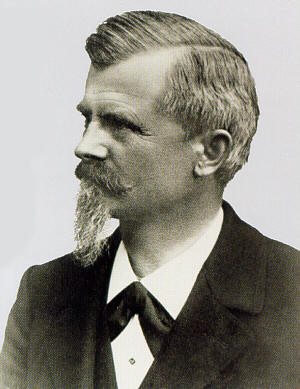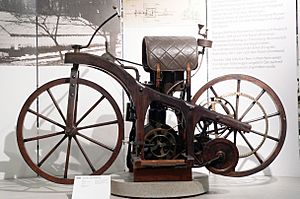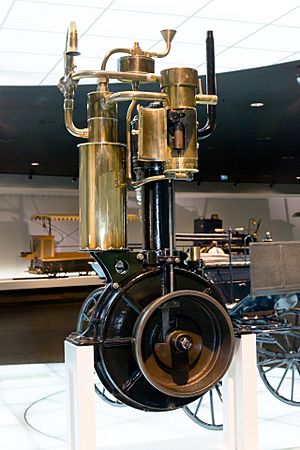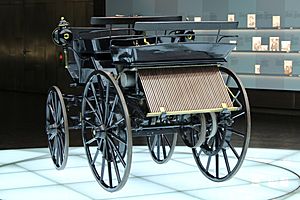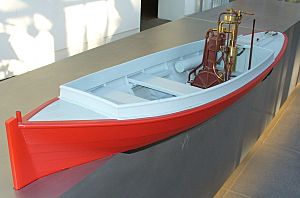Gottlieb Daimler facts for kids
Quick facts for kids
Gottlieb Daimler
|
|
|---|---|

Gottlieb Daimler in the 1890's
|
|
| Born |
Gottlieb Wilhelm Daimler
17 March 1834 Schorndorf, Kingdom of Württemberg
|
| Died | 6 March 1900 (aged 65) |
| Nationality | German |
| Occupation | Engineer, industrialist, automotive pioneer |
| Known for | Daimler Motoren Gesellschaft (Daimler Motors Corporation, DMG) |
Gottlieb Wilhelm Daimler (born March 17, 1834 – died March 6, 1900) was a German engineer and inventor. He was born in Schorndorf, Germany. Gottlieb Daimler was a pioneer in developing internal-combustion engines and cars. He invented the first high-speed engine that ran on liquid fuel.
Daimler and his partner, Wilhelm Maybach, wanted to create small, fast engines. These engines could power different kinds of vehicles. In 1883, they designed a new engine. It was a horizontal engine that used liquid fuel. This engine could run at high speeds and its power could be controlled. This made it perfect for transportation. They called this engine "Daimler's Dream."
In 1885, they made a vertical version of this engine. They put it into a two-wheeled vehicle. This was the first motorcycle powered by an internal combustion engine. It was called the Petroleum Reitwagen (Riding Car). The next year, they put the engine into a coach and a boat. Daimler called this engine the "grandfather clock engine" because it looked like a tall clock.
In 1890, Daimler and Maybach started a company called Daimler Motoren Gesellschaft (DMG). This means Daimler Motors Corporation. They sold their first car in 1892. Daimler became ill and left the business for a while. When he came back, he had problems with other owners. This led to his resignation in 1893, but he returned in 1894. Maybach also left and then came back. Daimler died in 1900, and Maybach left DMG in 1907.
Contents
- Early Life and Education: Becoming an Engineer
- Working with Wilhelm Maybach
- The Otto Four-Stroke Engine and New Ideas
- Inventing Small, High-Speed Engines (1882)
- The Dream Engine of 1883
- The 1885 Grandfather Clock Engine
- The First Automobile (1886)
- Daimler-Maybach's First Built Automobile (1889)
- Daimler Motors and the Phönix Engine (1890-1900)
- Daimler Motoren Gesellschaft and First Car Sold (1890)
- Founding of Daimler-Benz
- Honors and Legacy
- Images for kids
- See also
Early Life and Education: Becoming an Engineer
Gottlieb Wilhelm Daimler was the son of a baker. His parents were Johannes and Frederika Daimler. They lived in Schorndorf, near Stuttgart, Germany. By age 13, in 1847, Gottlieb had finished six years of primary school. He became very interested in engineering.
After finishing secondary school in 1848, Daimler trained as a gunsmith. He completed his training in 1852. He passed his trade test by making a pair of pistols. In the same year, at 18, Daimler decided to study mechanical engineering. He left gunsmithing and his hometown.
Daimler enrolled at Stuttgart's School for Advanced Training in Industrial Arts. He studied under a teacher named Ferdinand von Steinbeis. Daimler was a hard worker. He even took extra classes on Sunday mornings. In 1853, with help from Steinbeis, Daimler got a job. He worked at a factory called Rollé und Schwilque (R&S) in Grafenstaden. Daimler did very well there. In 1856, when R&S started making locomotives, Daimler, then 22, became a foreman.
Instead of staying, Daimler spent two years at Stuttgart's Polytechnic Institute. He wanted to improve his skills. He learned a lot about steam locomotives. He also became sure that steam power would be replaced. He imagined small, simple, and cheap engines for light industry. He might have been inspired by the new gas engines of that time.
In 1861, he left R&S. He visited Paris, then went to England. He worked with top engineering companies there. He learned a lot about machine tools. He spent two years in England, from 1861 to 1863. England was known as "the motherland of technology" then. He visited the 1862 International Exhibition in London. There, he saw a steam carriage. However, he was more interested in making machine tools.
Working with Wilhelm Maybach
Daimler went to work for Maschinenfabrik Daniel Straub. There, he designed tools, mills, and turbines. In 1863, he joined the Bruderhaus Reutlingen. This was a Christian Socialist toolmaker. He started as an inspector and later became an executive. While there, he met Wilhelm Maybach. Maybach was a 15-year-old orphan at the time. Daimler's good organization helped the factory make a profit. But he left in 1869, feeling frustrated. He then joined Maschinenbau Gesellschaft Karlsruhe in July.
In 1872, a company called N.A. Otto and Cie became Gasmotoren-Fabrik Deutz. The management chose Daimler as the factory manager. He joined in August and brought Maybach with him as chief designer. Daimler improved production. However, there were problems with Otto's engine design. Also, Daimler insisted on using atmospheric engines. This led to disagreements. Neither Otto nor Daimler would change their minds. Daimler was offered a choice: start a Deutz branch in St. Petersburg or resign. He chose to resign. He then started his own workshop in Cannstatt. Maybach soon joined him there.
The Otto Four-Stroke Engine and New Ideas
In 1872, Daimler and Maybach moved to Cologne. They worked at the Deutz-AG-Gasmotorenfabrik. This was the world's largest maker of stationary engines. Nicolaus Otto partly owned it and needed a new technical director. Both Daimler and Otto focused on gas-engine development. Maybach was the main designer.
In 1876, Otto developed a four-stroke cycle engine. It used gaseous fuel and a compressed charge. This system has four piston strokes: intake, compression, power, and exhaust. Otto wanted his invention to replace steam engines. But his engine was still basic and not very efficient.
Otto patented his engine in 1877. But one of his patents was soon challenged and overturned. Daimler wanted to make his own engine. He worried Otto's patent would stop him. Daimler hired a lawyer. The lawyer found that a similar patent existed. A French engineer named Beau De Rochas had patented a four-stroke engine in Paris in 1862.
Meanwhile, Daimler and Otto had big disagreements. Otto was reportedly jealous of Daimler's university education and knowledge. Daimler wanted to build small engines for transportation. But Otto was not interested in this idea. When Otto excluded Daimler from his engine patents, there was a lot of bad feeling. Daimler was fired in 1880. He received money and shares in Deutz-AG. Maybach resigned later and followed Daimler.
Inventing Small, High-Speed Engines (1882)
In Cannstatt, Daimler and Maybach designed their new engine. Daimler insisted on getting rid of the "clumsy, complicated slide-valve ignition." Instead, they used a hot tube system. An Englishman named Watson invented this system. Electrical systems at the time were too slow.
In the summer of 1882, Daimler moved to Cannstatt. He bought a cottage there. Maybach joined him in September. In the garden, they added a brick workshop to a glass-fronted summer house. Their work worried the neighbors. The neighbors thought they were making fake money. The police got a key from the gardener and raided the house. But they only found engines.
Daimler and Maybach spent many hours discussing how to fuel Otto's four-stroke design. They decided to use a common petroleum product. At that time, petroleum was mostly used for lubricating oil, kerosene (lamp fuel), and ligroin. Ligroin was mainly used as a cleaner and sold in pharmacies. They found that ligroin, a type of mineral spirit, worked well as a fuel.
The Dream Engine of 1883
In late 1883, Daimler and Maybach patented their first engine that used ligroin. This patent was granted on December 16, 1883. This engine met Daimler's goal: it was small and ran fast enough to be useful. It could reach 750 revolutions per minute (rpm). Over the next four years, improved designs reached 900 rpm. Daimler had three of these engines built in early 1884. One of them included a flywheel. This design was smaller and lighter than other engines of that time. Daimler used hot tube ignition until 1897. Then, he started using the electrical ignition designed by Bosch.
The 1885 Grandfather Clock Engine
The engine with the flywheel was put into a light vehicle. This vehicle was called the Reitwagen. It was the first vehicle powered by an internal combustion engine.
It took a lot of work and tests. But the two inventors finally perfected a 0.5 horsepower (hp) vertical engine. This engine was placed in the Reitwagen. This was a special two-wheeled frame with two small, spring-loaded stabilizer wheels.
Key features of the 1885 engine included:
- A single horizontal cylinder of 264 cubic centimeters (cc).
- Air cooling.
- A large cast iron flywheel.
- A surface carburetor.
- A hot tube ignition system.
- Cam-operated exhaust valves, allowing high speed.
- 0.5 hp power.
- Running speed of 600 rpm, much faster than older engines (120 to 180 rpm).
- Weight of about 50 kilograms (kg).
- Height of 76 centimeters (cm).
In 1885, they created a carburetor. This device mixed gasoline with air, allowing it to be used as fuel. In the same year, Daimler and Maybach built a larger version of their engine. It was still small, but now had a vertical cylinder of 100 cc. It produced 1 hp at 600 rpm. They called it the Standuhr (which means "grandfather clock"). Daimler thought it looked like an old pendulum clock.
In November 1885, Daimler put a smaller version of this engine into a wooden two-wheeled frame. It had two outrigger wheels. This created the first internal combustion motorcycle. It was named the Reitwagen (riding car). Maybach rode it for three kilometers (two miles). He rode it along the Neckar river, from Cannstatt to Untertürkheim. It reached a speed of 12 kilometers per hour (km/h).
The First Automobile (1886)
In 1886, Karl Benz and Gottlieb Daimler each created an automobile. They did this independently, about 60 miles apart in Germany.
In Mannheim, Karl Benz built a car. It had an engine he designed himself. He received a patent for his motorwagen on January 29, 1886.
Daimler's engine proved it could power a vehicle. So, he designed a 1.1 hp engine. He ordered a four-seater phaeton carriage from Wimpff und Söhne to put it in. Daimler's engine was installed by Maschinenfabrik Esslingen. It drove the rear wheels using a belt drive system.
On March 8, 1886, Daimler and Maybach secretly brought an American coach into the house. They told neighbors it was a birthday gift for Mrs. Daimler. Maybach oversaw the installation of a larger 1.1 hp, 462 cc engine into this coach. This became the first four-wheeled vehicle to reach 16 km/h. The engine's power was sent through belts. Like the motorcycle, it was tested on the road to Untertürkheim. Today, the Mercedes-Benz Arena is located there.
Daimler wanted to use the engine in as many ways as possible. So, he and Maybach used it in other types of transport:
- On water (1886): They put the engine in a 4.5 meter (m) long boat. It reached a speed of 6 knots. The boat was named Neckar after the river where it was tested. This was the first motorboat. Boat engines soon became Daimler's main product for several years. Early customers worried the petrol engine might explode. So, Daimler hid the engine with a ceramic cover. He told them it was "oil-electrical."
- Street-cars and trolleys: They also used the engine in these.
- In the air (1888): They used the engine in Daimler's balloon. This is often seen as the first airship. It replaced a hand-operated engine. With the new engine, Daimler successfully flew over Seelberg on August 10, 1888.
They sold their first foreign licenses for engines in 1887. Maybach went to the 1889 Paris Exposition. He showed their inventions there.
Daimler-Maybach's First Built Automobile (1889)
| · high speed four-stroke petrol engine |
| · fuel vaporization |
| · 2 cylinders V-configured |
| · mushroom shaped valves |
| · water-cooled |
| · 4 speed toothed gearbox |
| · pioneer axle-pivot steering system |
Engine sales grew, especially for use in boats. In June 1887, Daimler bought another property in Cannstatt. It was on Seelberg hill, away from the town. The mayor of Cannstatt did not approve of their workshop. The new place cost 30,200 goldmarks. It had room for 23 employees. Daimler handled the business side. Maybach managed the engine design.
In 1889, Daimler and Maybach built the Stahlradwagen. This was their first car that was not just a horse-drawn carriage with an engine added. Its design was somewhat influenced by bicycles. It was not produced in Germany. But it was licensed to be built in France. Both engineers showed it to the public in Paris in October 1889. That same year, Daimler's wife, Emma Kunz, died.
Daimler Motors and the Phönix Engine (1890-1900)

Demand for engines was growing. They were used in motorboats, railcars, and more. So, Maybach and Daimler expanded their business. With money from investors, Daimler Motoren Gesellschaft (DMG) was founded on November 28, 1890. Maybach became the chief designer. The company's goal was to build small, high-speed engines. These engines would be for land, water, and air transport. Daimler showed these three uses in a sketch. This sketch became the basis for the famous three-pointed star logo.
From 1882 to 1890, Daimler did not want to turn his company into a stock company. He had seen many inventors lose control of their own companies. This happened when stockholders took over. This is a common problem in business. It happened to Henry Ford and Karl Benz, among others.
Daimler hated having to make his company a corporation. He could not get majority control. So, he sold his shares and resigned. DMG grew, but it changed. The new owners did not believe in making cars. They ordered more stationary engine production. They even thought about merging DMG with Otto's Deutz-AG.
Daimler and Maybach wanted to produce cars. They disagreed with the new board members. Maybach was not allowed on the board. So, on February 11, 1891, he left the business. He continued his design work as a freelancer in Cannstatt. Daimler supported him. In the autumn of 1892, Maybach moved to the closed Hermann Hotel. He used its ballroom and winter garden as workshops. He hired twelve workers and five apprentices.
The new company developed a high-speed, inline-two engine called the Phönix. Maybach invented a spray carburetor for it. This engine was put into a car that started production in 1895. This happened after Daimler, Maybach, and the DMG board settled their disagreements.
Daimler Motoren Gesellschaft and First Car Sold (1890)
In 1890, Daimler started his own engine business, Daimler Motoren Gesellschaft (DMG). Its goal was to build the small, high-speed engines they had developed. These engines were based on the same stationary engine technology. In 1892, DMG finally sold its first car. Gottlieb Daimler, at 58, had heart problems. He suffered a collapse in the winter of 1892–1893. His doctor told him to go to Florence. There, he met Lina Hartmann, a widow 22 years younger. She owned the hotel where he was staying. They married on July 8, 1893. They spent their honeymoon in Chicago during its World Fair.
After returning from the 1893 World's Fair, Daimler wanted to buy enough shares of DMG to regain control. This did not work. Daimler sold all his shares and patents. He resigned from the company. Maybach had left earlier.
The arguments with the board continued. Daimler tried to buy more shares to get control. But he was forced out of his job as technical director. The company owed 400,000 Gold marks. The other directors threatened to declare bankruptcy. They said Daimler had to sell them all his shares and patent rights. Daimler accepted the offer. He received 66,666 Gold Marks and resigned in 1893.
In 1894, at the Hermann Hotel, Maybach, Daimler, and his son Paul designed a third engine. They called it the "Phoenix." DMG made it. It had:
- Four cylinders cast in one block, arranged vertically.
- Camshaft-operated exhaust valves.
- A spray nozzle carburetor, patented by Maybach in 1893.
- An improved belt drive system.
This engine was likely the one mentioned by American historian Henry Brooks Adams. He described the "Daimler motor" and its great speed. He saw it at the 1900 Paris Exposition.
Daimler and Maybach kept working together. They built a four-cylinder engine with Maybach's spray nozzle carburetor. This engine was in the first organized car race, "Paris to Rouen." It beat all the cars from DMG. Frederick Simms, a friend of Gottlieb Daimler, insisted that Daimler return to the company. Simms offered to pay £17,500 for the rights to use Daimler's engines in his British Daimler Company. This would help DMG's finances. Simms made it a condition that Daimler, then sixty years old, return to DMG. Gottlieb Daimler received 200,000 goldmarks in shares, plus a 100,000 bonus. Simms got the right to use the name "Daimler" for his company's products. In 1895, DMG assembled its 1,000th engine. Maybach returned as General Inspector. He received 30,000 shares.
During this time, they agreed to licenses to build Daimler engines worldwide. These included:
- France: From 1890, by Panhard et Levassor and Peugeot.
- United States: From 1891, under Daimler Motor Company in Long Island City. This was a partnership with American and German piano maker Steinway & Sons.
- United Kingdom: From 1893, by Frederick Simms' Daimler Motor Syndicate. This was transferred in 1896 to the Daimler Motor Company.
- Austria: By Austro Daimler.
Daimler died in 1900. In 1907, Maybach resigned from DMG.
Founding of Daimler-Benz
Daimler created the first liquid petroleum vehicle in 1885. Karl Benz developed the first purpose-built car using his own two-cycle engine a few months later. Daimler and Karl Benz never met each other during their invention period. In 1896, Daimler (DMG) sued Benz & Cie for breaking his 1883 patent on hot tube ignition. Daimler won, and Benz had to pay money to DMG. Even after the court case, Daimler and Karl Benz still did not speak to each other.
Years after Daimler died, the two companies worked together in many ways. After many years of cooperation, on June 28, 1926, representatives from Daimler-Motoren-Gesellschaft (DMG) and Benz & Cie signed an agreement. They merged the two oldest car manufacturers in the world. The new company was named Daimler-Benz AG.
Honors and Legacy
Gottlieb Daimler was honored in the Automotive Hall of Fame in 1978. Between 1993 and 2008, a stadium in Stuttgart, Germany, was named after him. This stadium, the Mercedes-Benz Arena, hosted six matches in the 2006 FIFA World Cup.
Gottlieb Daimler's motto was Das Beste oder nichts. This means "The best or nothing at all." Mercedes-Benz adopted this motto as their slogan in 2010.
Images for kids
-
Model of a DMG Lastwagen, 1896, first gasoline truck
See also
 In Spanish: Gottlieb Daimler para niños
In Spanish: Gottlieb Daimler para niños




